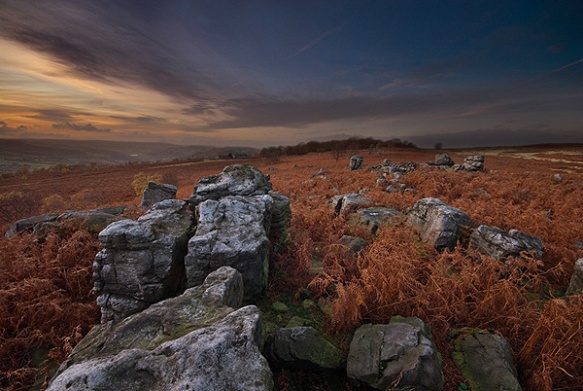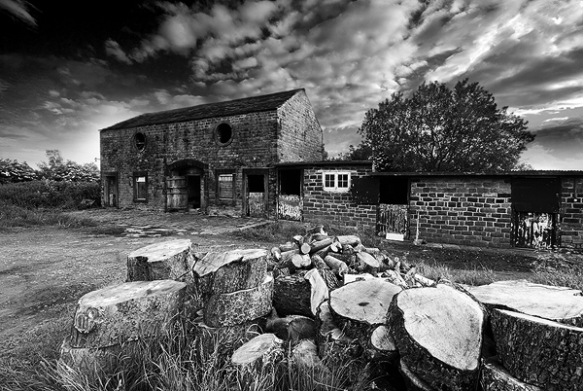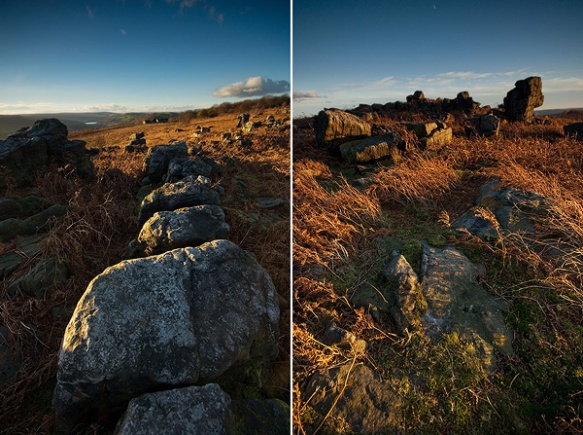“In that pleasant district of merry England which is watered by the river Don, there extended in ancient times a large forest, covering the greater part of the beautiful hills and valleys which lie between Sheffield and the pleasant town of Doncaster. The remains of this extensive wood are still to be seen at the noble seats of Wentworth, of Warncliffe Park, and around Rotherham. Here haunted of yore the fabulous Dragon of Wantley; here were fought many of the most desperate battles during the Civil Wars of the Roses; and here also flourished in ancient times those bands of gallant outlaws, whose deeds have been rendered so popular in English song.”
Walter Scott, Ivanhoe.
Wharncliffe Chase is an area of wild upland above the southern end of Wharncliffe Crags, north of Sheffield. Prehistoric human settlement is evidenced by a Mesolithic camp near Deepcar and a settlement at the northern end of the crags. Over 2000 quern stones have been found along the crags, dating back to the Iron Age. There also seems to be some evidence that the Romans passed this way too. Following the Norman Conquest, Wharncliffe was one of the many ‘chases’ in the area set aside as a royal hunting park for the Lords of Hallamshire.
The Wortley family have had a home on the site of Wortley Hall, probably since Norman times. It was Sir Thomas Wortley that built the first lodge at the top of the crags in 1510, there have been two other Wharncliffe Lodges since, the current structure being a Victorian rebuild. Some features of the original lodge still remain.
The Wortleys seem to have had a rare talent for annoying the locals, especially by enclosing land for their deer park. Two hamlets were destroyed when the chase was extended, Stanfield and Whiley and it was the actions of Richard Wortley in 1589 that led to bitter conflict with locals and the creation of the satirical ballad, ‘The Dragon of Wantley.’ In 1591, eleven people were charged with hunting deer in the park and vandalising walls and fences. They are also said to have hung the body of a deer from gallows and nailed it’s head to Wortley Church door. In 1603 George Blount of Moore Hall disputed Wortley’s attempted increase in tithe payments and won his case. It maybe that the character of More of More Hall in the tale is based on him.
All sorts of cattle this dragon would eat, Some say he ate up trees, And that the forests sure he would devour up by degrees: For houses and churches were to him geese and turkeys; He ate all and left none behind, But some stones, dear Jack, that he could not crack, Which on the hills you will find.
The tale of the Dragon of Wantley tells how a dragon, living in a cave in the crags (there is still a cave known as ‘Dragon’s Den’ near Wharncliffe Lodge), terrorised the locals by preying upon their children and cattle. The knight, More of More Hall takes on the dragon in battle, wearing a suit of spiked armour, waiting in a pond for the dragon to come and drink. More kills the dragon either (depending on which version you read) with a blow or by allowing the dragon to coil around him and squeeze, thus impaling itself of his spikes.
His son Francis Wortley, seems to have continued the family tradition of antagonism and fought a duel with Sir John Savile (of the Saviles of Tankersley) in 1626. Wortley, along with the Wentworths, sided with the Royalists during the English Civil War. He was imprisoned in the Tower of London in 1644, his estates confiscated, to be returned upon payment of a fine.
The lodge is still in the ownership of the Wortley family. A later resident stocked the deer park with North American Bison and occasionally, the odd bison bone still turns up around the chase.





